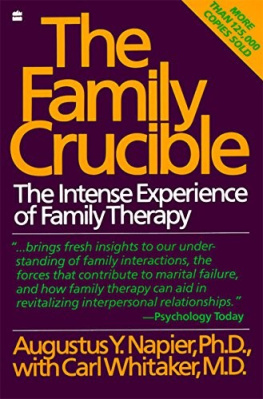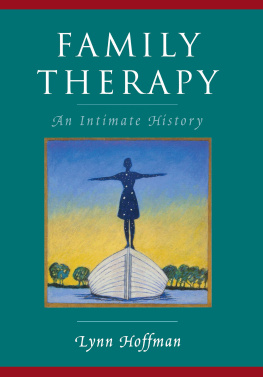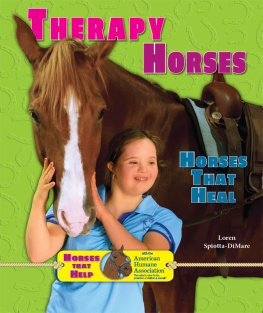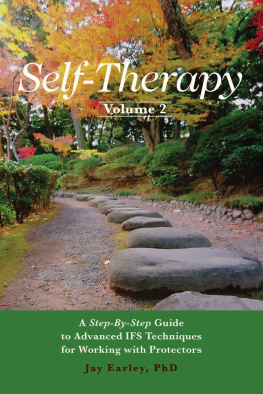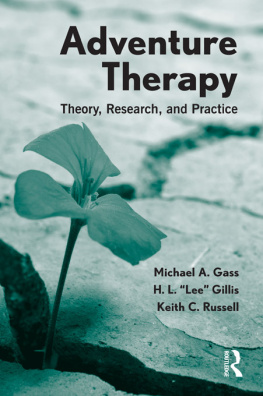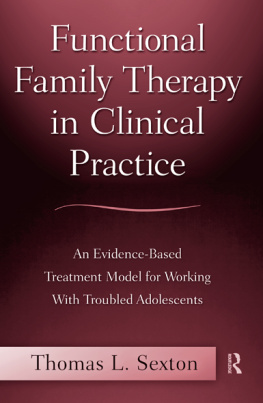THE FAMILY CRUCIBLE
THE FAMILY CRUCIBLE
Augustus Y. Napier, Ph.D. with
Carl A. Whitaker, M.D.
HARPER NEWYORK . LONDONTORONTO . SYDNEY
Epigraph from James Agee and Walker Evans, Let Us Now Praise Famous Men (Boston: Houghton Mifflin Company, 1960). Reprinted with permission of the publisher.
THE FAMILY CRUCIBLE. Copyright 1978 by Augustus Y. Napier and Carl A. Whitaker. All rights reserved. Printed in the United States of America. No part of this book may be used or repro duced in any manner whatsoever without written permission except in the case of brief quota tions embodied in critical articles and reviews. For information address HarperCollins Publishers Inc., 10 East 53rd Street, New York, NY 10022.
HarperCollins books may be purchased for educational, business, or sales promotional use. For information please write: Special Markets Department, HarperCollins Publishers Inc., 10 East 53rd Street, New York, NY 10022.
First PERENNIAL LIBRARY edition published 1988. Reprinted in Quill 2002.
Designed by Sidney Feinberg
Library of Congress CataloginginPublication Data Napier, Augustus.
The family crucible.
"Perennial Library."
Includes index.
1. Family psychotherapyCases, clinical reports, statistics.
I. Whitaker, Carl A., joint author.. II. Title.
RC488.5.N36 1988 616.8*915 ISBN 0060914890 (pbk.)
741872
08 09 RRD 50 49 48 47 46 45
This family must take care of itself; it has no mother or father; there is no shelter, nor resource, nor any love, interest, sustaining strength or comfort, so near, nor can anything happy or sorrowful that comes to anyone In this family possibly mean to those outside it what it means to those within it; but it is, as I have told, inconceivably lonely,
drawn upon itself as tramps are drawn round a fire in the cruelest weather; and thus and in such loneliness it exists among other families, each of which is no less lonely, nor any less without help or comfort, and is likewise drawn in upon itself....
JAMES AGEE AND WALKER EVANS Let Us Now Praise Famous Men
To the Memory of My Parents, Augustus and Mary Ethel Napier
Foreword
x i
1 12 35 45 60 79 95
107 123 139 147 162 171
1. The Question of Structure A Beginning
Origins
The Concept of the System Initiative
The Basic Conflict
7. Grandmother's Ghost
Toward Marriage
A Partial Resolution
Releasing
11. The Underlying Crisis 12. Return
13. Hate
Contents
X
THE FAMILY CRUCIBLE
The Therapeutic Moment 181 Collision Course
16. Carolyn
17. The Terrible Choice
David 231
19. David's Family 247
Ending Therapy
Forum
Suggested Readings Index
Foreword
I began this book when I was in the last stages of training with Carl Whitaker, family therapist and professor of psychiatry at the Univer sity of Wisconsin. I came to the Psychiatry Department both to study with Carl and to complete an internship, the last requirement for a Ph.D. in clinical psychology from the University of North Carolina. Family therapy had become my major interest during graduate school, and I was fortunate to find an internship where I could study with such a skilled and widely respected family therapist. A postdoc toral fellowship allowed me to continue the training for a second year, and Carl's generosity extended my apprenticeship through two years of more informal work.
Like many medical schools, Wisconsin honors an old tradition which encourages the medical professor to maintain a small private practice which keeps him abreast of the difficulties of practicing what he teaches. Carl also uses his private practice directly as a teaching medium. Though I attended many seminars and received supervi sion of my own cases, my most valuable training was in being Carl's cotherapist with a number of families in his private practice. Out of that experience came the impetus for this book.
These interviews were powerful events for me. Some of the sense of power derived from Carl's clinical skill and from his personal force; some of it came from the family's impressive struggle to change its own destiny; some of it seemed to come out of our teaming as cotherapists. I knew that there was a great deal of interest in family therapy among professionals, but little awareness of this excit
xii THE FAMILY CRUCIBLE
ing new field among lay persons. I wanted to document some of the changes in families that I had witnessed during my training.
In the beginning I went over audiotapes of interviews that Carl and I had conducted together, and I studied videotapes of consulta tion interviews that he had led in various training institutes. Digging into these interviews was fascinating, but it was also frustrating. I quickly became enmeshed in a nightmare of complexity as I tried to describe the nuances of voice, the peculiarities of phrasing, the intri cate sequence of events in the interviews. I wrote fifty pages about a single hour of therapy and felt that I had treated the material superficially! So focused was I on details that I lost all sense of the flow and the drama of family therapy.
I decided to step back from the material and to try to capture the "feel" of family therapy. Choosing a family whose treatment had been recorded on audiotape and which I had studied carefully, I began to write from memory, drawing in episodes from other cases as they seemed useful to illustrate the process of therapy. I added paragraphs and chapters of explanation to clarify both this case and the larger family therapy approach. While every major episode of the Brices' therapy is based on an actual occurrence, their story is truly a composite of various families' experiences in therapy, and is there fore a fictionalized account. Nevertheless, I think the result is a more accurate portrayal of family therapy than was my earlier presenta tion of the "facts."
The book went with me through a number of experiences. As my own career developed, I shifted from being Carl's student to being his friend and colleague. I found that in my own private practice I began to develop ideas about family therapy that were somewhat different from Carl's; and while my separate views have only served to enrich our association, the book had to change as I changed.
By injecting more of my own view of family therapy into this book, I may have failed to render an accurate portrait of Carl's subtle and indirect artistry. Those who know his work well may feel that I did not capture fully his skillful use of paradox, metaphor, and humor. This omission is the inevitable consequence of the writer's seeing the world through his own eyes. When Carl talks to the family he sometimes speaks the language of the unconscious mind; I tend to speak to the conscious mind and to "teach." Fortunately or unfor tunately, the language here is predominantly mine.
FOREWORD xiii
Although I conceived the idea of the book and did all the writing, I had a great deal of assistance from several people. Carl's ideas form the real basis for this book. He also collaborated closely with me as I wrote. We outlined the conceptual chapters together, and he off ered many helpful suggestions as the book was revised.
Ann Harris, my editor, has been a major contributor to this effort. Her warm, buoyant voice sustained me through periods of discour agement, and her extremely perceptive commentary taught me about much more than the technicalities of writing. Like a good therapist, she not only counseled me to be true to myself, but helped me see more clearly what is natural for me. Ann labored longer and harder over this manuscript than I ever imagined an editor doing, and I am grateful to her.
A number of people read the manuscript and offered useful suggestions, among them my wife, Margaret, my students, and David Keith, a family therapist who is both Carl's and my close associate.
Next page
